One of the cultural appointments of major relevance of the Art Week in London, although it as a whole had an independent format given its distinctive and experimental character in an interdisciplinary and activistic sense, was definitely the Guest, Ghost, Host: MACHINE! Marathon curated by Hans Ulrich Obrist for the Serpentine Galleries where he is the artistic director. This year’s edition took place in the comfortable space of the prestigious City Hall equipped with the modern devices of the Serpentine Radio. The evening before the opening, there was an introductory performance at the “Magazine” (projected by the archistar Zaha Hadid), two talks between Obrist, Sarah Morris and Manthia Diawara. The topic of the Marathon was in particular the phenomenon of Artificial Intelligence (in steady growth) comparing the knowledges of philosophers, sociologists, biologists, botanists, anthropologists and of scientists, mathematicians, architects, film and theater directors, prose writers and poets, artists and art critics, managers of institutions. The event consisted of a kind of laboratory of interconnections, where each world known highly qualified personality showed the results of researches, studies and experiences in his own field, through an oral presentation as well as a practical one, by combining the urgencies of the present with the visions of the future. In the meantime the radio broadcasts favoured further communication and exchange of ideas. From 10am until late night the speakers followed one after the other at a rapid pace, all of them duly presented by HUO and supervised by a qualified staff. In this rigorous context, there were also surprising avant-garde performances, physical as well as musical, that all contributed to hold the numerous onlookers’ attention.
My new talk with Obrist – undisputed leader of the international art system; a no stop marathoner of innovative curating projects – sprang from the theme of the event and spread to probable development of virtual reality and its effects, that can be or cannot be shared, in the aesthetic, scientific and human area of interest.
Luciano Marucci: In short, how should your concept of performed “activism”, which in particular characterize the Marathons of the Serpentine, be interpreted?
Hans Ulrich Obrist: Today there is a need to answer the demands of the twenty first century and to connect many disciplines. The idea is to set up a Festival of the Knowledges with the intention to compare different points of view. The 2017 edition’s chosen topic was the artificial intelligence which has a connection with the critical theme of the work in the future.
Does your activist strategy in certain use your projects’ planned “interaction” with the audience and also the “transdisciplinarity” where the knowledges have a cultural, social and economical function?
We have just inaugurated the exhibition Take Me (I’m Yours), curated by me with Christian Boltanski, Chiara Parisi and Roberta Tenconi at HangarBicocca. This exhibit is about changing the rules of the game as it modifies the habits we have when visiting a museum. Here we can do things that are normally forbidden in a museum. The Marathons spring from the idea of finding a way of setting up events that so far have always had rigid rules, in other words how we can create a hybrid where the participants take active part, perform and ‘manifests’… The idea is in the format, in what way we manage to develop more fluid formats.
Hence, the experts’ debate regarding the chosen theme of the Marathons is connected with the socio-cultural growth of the reality in becoming?
Yes, absolutely, but it is also a resistance because every year a new topic which we consider basic or critical for the society, is chosen. We always find an important topic, not only regarding art, but essential for the destiny of the world.
Could we say that the mix of “activism”, “interaction” and “interdisciplinarity” defines the identifying feature of the various editions of the event?
Choosing the theme entails a long process, a very systematic one. Every year we take a look at a list of matters that seem to be pressing and finally we decide for one that has not been debated and that at the moment has a major critical weight.
In your opinion, can the artificial intelligence, which is a result of human brilliance, increase the inventive abilities and reduce the attraction for the physical reality?
I think that we today with the artificial intelligence can have a situation that permits us to create a benevolent super intelligence. The engineer Kenric McDowell spoke about this in his conversation, but if we find/end up with a malevolent superintelligence we should oppose to it.
Can creatives on the whole, also those of non artistic disciplines, foster the artificial intelligence in a way that it becomes nearly self generative?
The important thing is that art takes part in these discussions. Nowadays there is an intense debate about this, Nick Bostrom [director of Future of Humanity Institute] in Oxford is very critical, so is also the cosmologist Max Stenmark. In our Marathon, a very interesting part was the panel discussion with John Brockman (moderator), Venki Ramakrishnan, President of the Royal Society, Andrew Blake e Jaan Tallin (a supporter of Bostrom’s iniziatives) who discussed a lot, appearing to be critical. Art has to take part in these debates, to have its place at the table.
Will the art of tomorrow depend more on cutting-edge media?
We can never say that art is forced in this sense. As I have said other times, I think there are parallel realities such as drawing, sculpturing and painting that can continue to coexist with cutting-edge technologies. Well, yes, there are these new forms based on algorithms, but a form doesn’t exclude another.
Could the digital creativity, so precarious and performative, be the main form of art in the future?
It will be an important reality, but not the main one. I think it will be an additional opportunity. All you have to do is to take a look at “Serpentine’s” programme. Soon there will be two simultaneous exhibitions, paintings by Rose Wylie’s [inspired by art history, cinema, comic strips, daily life events] and Ian Cheng’s works based on evolutionary algorithms [works that examine the nature of the changes and men’s ability to deal with them]. We cannot say that one or the other will dominate, because, as I said, they are parallel realities.
Artists like Ed Atkins and Al Maria – who you know well – create interesting works using the digital methodology.
Yes, for sure. They are artists that deal with several disciplines, art, performing, cinema and architecture, and key players able to make the fluid borders between the disciplines
Let’s wait and see where the “Time machine” will take us. If I am not wrong, you too have put it into use to try and discover far in advance where we are moving to?
We should not close the discussions, but open them. This year’s Marathon did not embrace the idea of artificial intelligence in an unquestioning way, but gave light to different viewpoints of the theme also the one that analyzes the critical aspects.
For sure the digital revolution will change a certain physicality of everyday life, but the important thing is that, through increased reality, an inhuman world is not re-created and that our wish to socialize remains. What do you think?
It is of basic importance not to create isolation, but let the new technologies help establish dialogues among human beings. For this reason, art has to participate as a substantial part in the debate.
(Conversation via Skype, November 2th, 2017, 01:39-01:55am)
Luciano Marucci (Translation by Kari Moum)
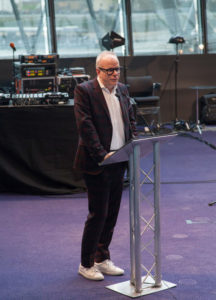 Hans Ulrich Obrist introduce “Guest, Ghost, Host: MACHINE!” Marathon, City Hall, Londra, 7 ottobre 2017 (courtesy Serpentine Galleries; ph © Plastiques Photography)
Hans Ulrich Obrist introduce “Guest, Ghost, Host: MACHINE!” Marathon, City Hall, Londra, 7 ottobre 2017 (courtesy Serpentine Galleries; ph © Plastiques Photography)
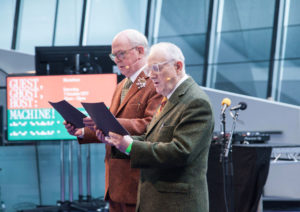 Gilbert & George durante il loro intervento “GODOLOGY!” (courtesy Serpentine Galleries e gli artisti; ph © Plastiques Photography)
Gilbert & George durante il loro intervento “GODOLOGY!” (courtesy Serpentine Galleries e gli artisti; ph © Plastiques Photography)
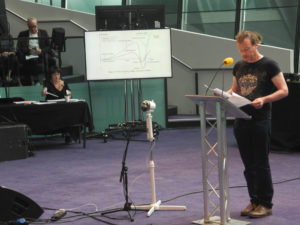 Timothy Morton, autore del libro “Hyperobjects: Phiposophy and Ecology after the End of the World”, alla Marathon. Davanti a lui il robot Siri; sulle gradinate Hans Ulrich Obrist (courtesy Serpentine Galleries; ph Luciano Marucci)
Timothy Morton, autore del libro “Hyperobjects: Phiposophy and Ecology after the End of the World”, alla Marathon. Davanti a lui il robot Siri; sulle gradinate Hans Ulrich Obrist (courtesy Serpentine Galleries; ph Luciano Marucci)
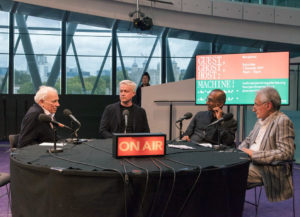 Panel discussion (da dx): John Brockman (moderatore), Jaan Tallinn (inventore di Skype), Venki Ramakrishnan (Premio Nobel 2009 per la chimica) e lo scienziato Andrew Blake (courtesy Serpentine Galleries; ph © Manuella Barczewski)
Panel discussion (da dx): John Brockman (moderatore), Jaan Tallinn (inventore di Skype), Venki Ramakrishnan (Premio Nobel 2009 per la chimica) e lo scienziato Andrew Blake (courtesy Serpentine Galleries; ph © Manuella Barczewski)
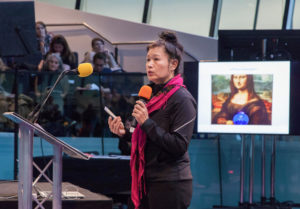 L’artista tedesca di origine giapponese Hito Steyerl in “Bubble Vision” (courtesy Serpentine Galleries; ph © Manuella Barczewski)
L’artista tedesca di origine giapponese Hito Steyerl in “Bubble Vision” (courtesy Serpentine Galleries; ph © Manuella Barczewski)
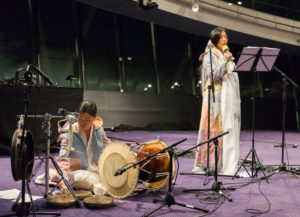 Zadie Xa con Jihye Kim in “Perfumed Purple Rice and Sateen Song for Sadie” (courtesy Serpentine Galleries; ph © Manuella Barczewski)
Zadie Xa con Jihye Kim in “Perfumed Purple Rice and Sateen Song for Sadie” (courtesy Serpentine Galleries; ph © Manuella Barczewski)
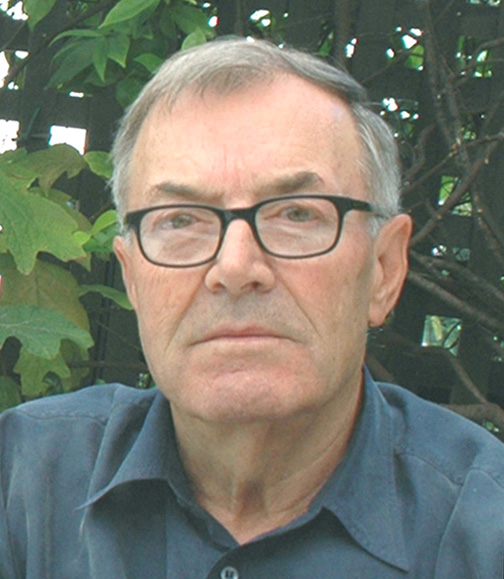
I’m Luciano Marucci, born by case in Arezzo and I look my age… After a period in which I dedicated myself to journalism, applied ecology, environmental education and traveling the world, I occasionally collaborated as an art critic with specialized magazines (“Flash Art”, “Arte & Critica”, “Segno”, “Hortus”, “Ali”) and with varied cultural periodicals. Since 1991 in “Juliet” art magazine (in print and edition) I have regularly been publishing extensive services on interdisciplinary topics (involving important personalities), reportages of international events, reviews of exhibitions. I have edited monographic studies on contemporary artists and book-interviews. As an independent curator I have curated individual and collective exhibitions in institutional and telematic spaces. I live in Ascoli Piceno.


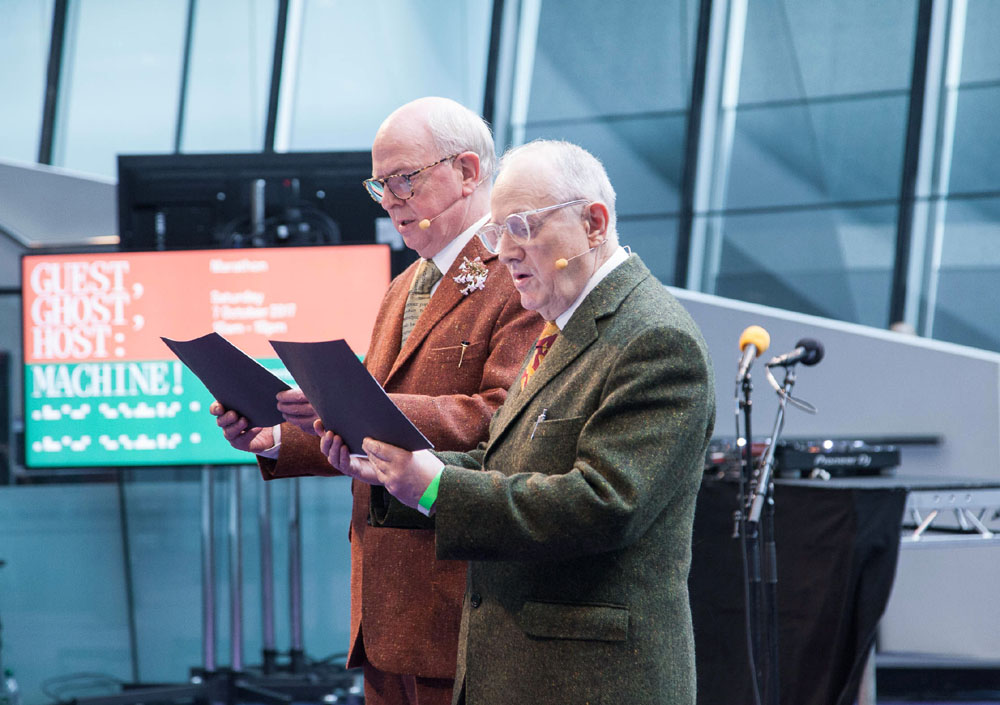

NO COMMENT